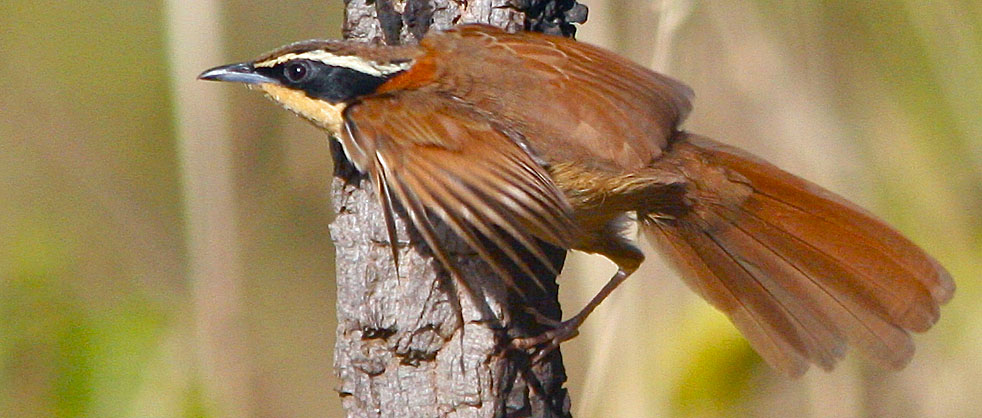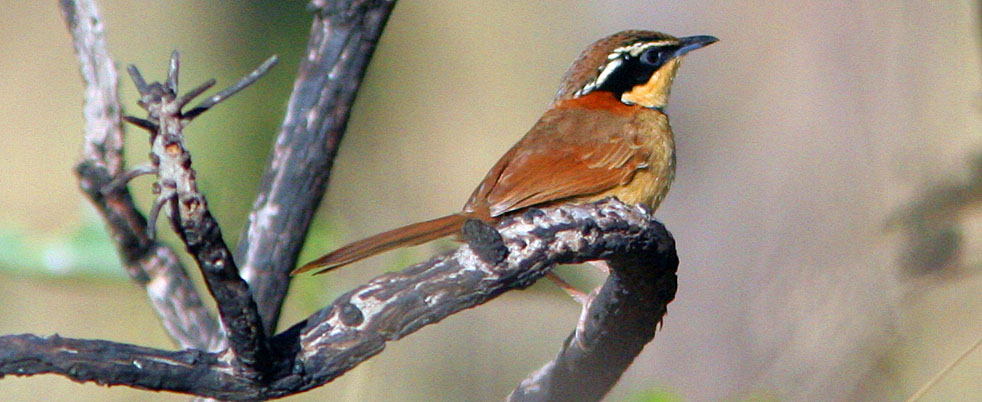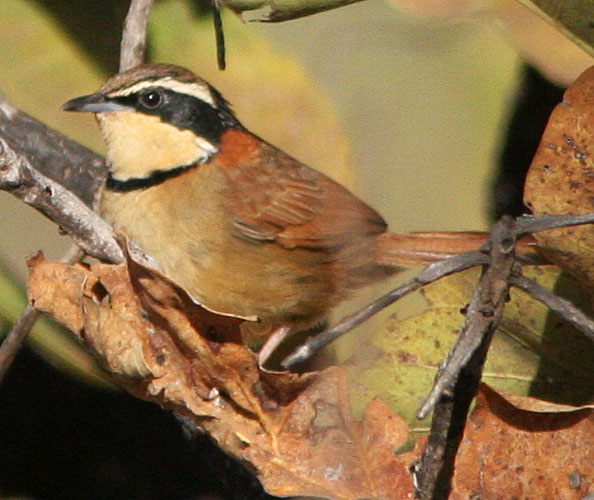
a web page by Don Roberson |
CRESCENTCHESTS Melanopareiidae |
|
Crescentchests have traditionally been placed with the tapaculos [family Rhinocryptidae] but Krabbe & Schulenberg (2003) wrote that the "four species of Melanopareia differ from all other tapaculos in so many characters that it is possible that they represent another clade. They are brightly coloured and relatively long-tailed, and two of them have a semi-concealed white intrascapular patch similar to that found in many antbirds. Most striking is the possession by this genus of seemingly primitive stapes of the inner ear." Recent genetic evidence has now elevated them to family status. |
 |
The relationships of crescentchests had long been uncertain. Cory & Hellmayr (1924) placed Melanopareia among the antbirds (then called Formicariidae, now Thamnophilidae) but Wetmore (1926) transferred it to the tapaculos (Rhinocryptidae) without a fully convincing explanation (there are some shared skeletal features with tapaculos). This placement was adopted in subsequent classifications (e.g. Meyer de Schauensee 1970, Ridgely & Tudor 1994) and has remained that way until now. There have been critics of this arrangement. Sick (1985) described the eggs of M. torquata as antbird-like, and Ridgely & Tudor (1994) noted that in external appearance, behavior, and vocalizations, species of Melanopareia are "decidedly untapaculo-like (more resembling antbirds)". Two recent phylogenetic studies employing mitochondrial and nuclear DNA data (Irestedt et al. 2002, Chesser 2004) show that crescentchests are only distantly related to other tapaculos, but appear to be an early branch of the entire antbird/ovenbird set. Irestedt et al. (2002) suggested that they be excluded from Rhinocryptidae and placed in a new family, Melanopareiidae. The South American Checklist Committee adopted this position and elevated the crescentchests to family-level status. The was confirmed by genetic evidence in Moyle et al. (2006). Two crescentchests are local species in arid country of coastal Ecuador and Peru, and appear quite closely related [Marañon Crescentchest M. maranonica and Elegant Crescentchest M. elegans] while the other two [Collared Crescentchest and Olive-crowed Crescentchest M. maximiliani] have more southern distribution in Bolivia, Brazil, Paraguay, and n. Argentina. These latter species have different voices and bear semi-concealed intrascapular patches (Krabbe & Schulenberg 2003). Here's a final shot of the same Collared Crescentchest (below). |
 |
Photos: All the photos of Collared Crescentchest Melanopareia torquata were taken at Emas NP, Brazil, on 26 July 2010. Photos © Don Roberson; all rights reserved Bibliographic note: There is no "family book" for this newly-minted family but a fine introduction to the genus Melanopareia, with some excellent photos, is in Krabbe & Schulenberg (2003), covering them when they were considered to be tapaculos. Literature cited:
|
 The colorful crescentchests (genus Melanopareia) inhabit arid habitats of central South America. The most widespread is the delightful Collared Crescentchest (left & both photos below). This is the only species I've seen in the Melanopareiidae so far. It was skulking through
the cerrado of southern Brazil, and was generally hard to see. I recall being quite shocked at how
striking this species was.
The colorful crescentchests (genus Melanopareia) inhabit arid habitats of central South America. The most widespread is the delightful Collared Crescentchest (left & both photos below). This is the only species I've seen in the Melanopareiidae so far. It was skulking through
the cerrado of southern Brazil, and was generally hard to see. I recall being quite shocked at how
striking this species was.